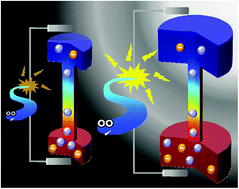Salt gradient driven ion transport in solid-state nanopores: the crucial role of reservoir geometry and size†
Abstract
Modern applications of nanotechnology such as salinity gradient power and ionic diodes usually involve the transport of ionic species in a system comprising a nanopore connecting two large reservoirs. The charge properties on the nanopore surface plays a key role, and they need to be estimated by fitting a mathematical model for the system to measurable quantities such as ionic current or conductance. This model can also be used to simulate the system behavior under various conditions. However, the large difference between the linear size of a nanopore and that of a reservoir makes relevant analyses difficult. Considering numerical efforts, the impact of the computational domain for the reservoir geometry and size on the system behavior is almost always overlooked in previous studies, where the computational domain for a reservoir is often assumed to have a relatively small size. Taking salinity gradient ionic current as an example, we show for the first time that the performance of a reservoir–nanopore–reservoir system is influenced appreciably by the computational domain for the reservoir geometry and size, especially when a voltage bias is not applied. Using the reported experimental data for the osmotic current in a single boron nitride nanopore, we show that its surface charge density can be estimated realistically by choosing an appropriate computational domain for reservoir geometry and size. Numerical simulation also reveals that choosing appropriate reservoir geometry and size is necessary; otherwise, the results obtained might be unreliable, or even misleading. To avoid this, we suggest that for the nanopore with the pore length smaller than 1000 nm, the size of the computational domain of a reservoir, (length × radius), with equal length and radius, should exceed 800 × 800 nm.


 Please wait while we load your content...
Please wait while we load your content...